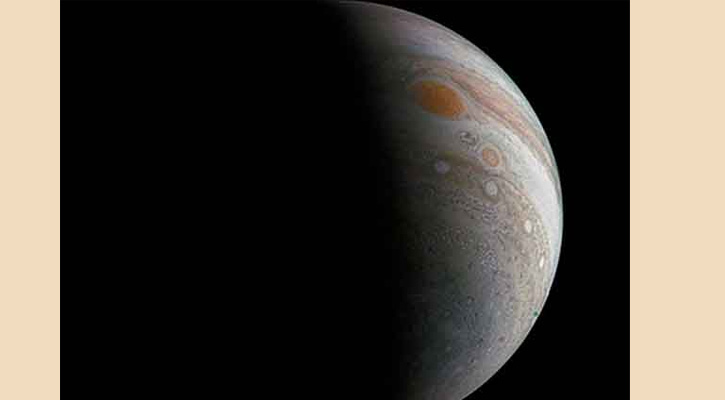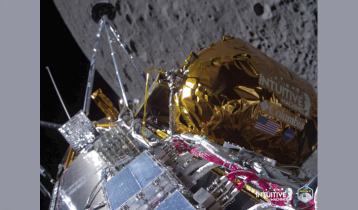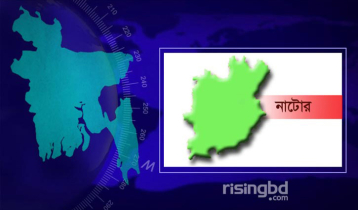The biggest storm in the universe
4 || risingbd.com

Risingbd Desk: It is a stunning new look at the biggest storm in the universe.
NASA has revealed an incredible new image of Jupiter created from data sent by its Juno probe.
It reveals the iconic great red spot, alongside a series of storms shaped like white ovals, known informally as the ‘string of pearls.’
The image of a crescent Jupiter and the iconic Great Red Spot was created by a citizen scientist (Roman Tkachenko) using data from Juno's JunoCam instrument, NASA said.
The image was taken on Dec. 11, 2016 at 2:30 p.m. PST (5:30 p.m. EST), as the Juno spacecraft performed its third close flyby of Jupiter.
At the time the image was taken, the spacecraft was about 285,100 miles (458,800 kilometers) from the planet.
Astronomers recently revealed that Jupiter's 'red spot' storm, the biggest in the solar system, is shrinking.
The so-called 'Great Red Spot' is a violent storm, which in the late 1800s was estimated to be about 25,000 miles (about 40,000 km) in diameter – wide enough for three Earths to fit side by side.
The biggest in the solar system, it appears as a deep red orb surrounded by layers of pale yellow, orange and white.
Winds inside the storm have been measured at several hundreds of miles per hour, NASA astronomers said.
NASA revealed the find alongside stunning new maps of the planet which are the first in an annual series of 'weather maps' designed to spot changes.
Already, the Jupiter images have revealed a rare wave just north of the planet's equator and a unique filamentary feature in the core of the Great Red Spot not seen previously.
'Every time we look at Jupiter, we get tantalizing hints that something really exciting is going on,' said Amy Simon, a planetary scientist at NASA's Goddard Space Flight Center in Greenbelt, Maryland.
Collecting these yearly images – essentially the planetary version of annual school picture days for children – will help current and future scientists see how these giant worlds change over time.
The observations are designed to capture a broad range of features, including winds, clouds, storms and atmospheric chemistry.
Simon and her colleagues produced two global maps of Jupiter from observations made using Hubble's high-performance Wide Field Camera 3.
The two maps represent nearly back-to-back rotations of the planet, making it possible to determine the speeds of Jupiter's winds.
The findings are described in an Astrophysical Journal paper, available online.
The new images confirm that the Great Red Spot continues to shrink and become more circular, as it has been doing for years.
The long axis of this characteristic storm is about 150 miles (240 kilometers) shorter now than it was in 2014.
Recently, the storm had been shrinking at a faster-than-usual rate, but the latest change is consistent with the long-term trend.
The Great Red Spot remains more orange than red these days, and its core, which typically has more intense color, is less distinct than it used to be.
An unusual wispy filament is seen, spanning almost the entire width of the vortex.
This filamentary streamer rotates and twists throughout the 10-hour span of the Great Red Spot image sequence, getting distorted by winds blowing at 330 miles per hour (150 meters per second) or even greater speeds.
In Jupiter's North Equatorial Belt, the researchers found an elusive wave that had been spotted on the planet only once before, decades earlier, by Voyager 2.
In those images, the wave is barely visible, and nothing like it was seen again, until the current wave was found traveling at about 16 degrees north latitude, in a region dotted with cyclones and anticyclones.
Similar waves – called baroclinic waves – sometimes appear in Earth's atmosphere where cyclones are forming.
'Until now, we thought the wave seen by Voyager 2 might have been a fluke,' said co-author Glenn Orton of NASA's Jet Propulsion Laboratory in Pasadena, California.
The wave may originate in a clear layer beneath the clouds, only becoming visible when it propagates up into the cloud deck, according to the researchers.
That idea is supported by the spacing between the wave crests.
In addition to Jupiter, the researchers have observed Neptune and Uranus, and maps of those planets also will be placed in the public archive.
Saturn will be added to the series later.
Hubble will dedicate time each year to this special set of observations, called the Outer Planet Atmospheres Legacy program.
'The long-term value of the Outer Planet Atmospheres Legacy program is really exciting,' said co-author Michael H. Wong of the University of California, Berkeley.
'The collection of maps that we will build up over time will not only help scientists understand the atmospheres of our giant planets, but also the atmospheres of planets being discovered around other stars, and Earth's atmosphere and oceans, too.'
Saturn also has a mysterious six-sided storm churning at Saturn's north pole.
The unusual geometric structure, which is around 20,000 miles (32,187 km) wide, rotates at almost exactly the same rate as Saturn spins on its axis.
The strange hexagonal structure, seen in the animation above from directly over Saturn's north pole, rotates at the same speed as the planet itself spins on its axis. It is more than 20,000 miles (32,190km) in diameter.
Scientists now believe it is formed by winds, similar to our own arctic jet stream, racing eastwards around the pole at cloud level and being jostled into shape by other winds below it.
The findings provide a 'simple' solution to the properties of the strangely shaped vortex, according to astronomers.
Writing in journal Astrophysical Journal Letters, Professor Raúl Morales-Juberías, a planetary scientist at the New Mexico Institute of Mining and Technology in Socorro, and his colleagues said the key to the shape appeared to be the height of the jet stream.
They constructed computer models of Saturn's dense atmosphere in the northern hemisphere to see how winds at different levels may behave.
They said: 'Past numerical and laboratory modelling efforts have succeeded in reproducing some, but not all, of the hexagon's characteristics.
'We present numerical simulations showing that instabilities in shallow jets can equilibrate as meanders closely resembling the observed morphology and phase speed of Saturn's northern hexagon.
'We also find that the winds at the bottom of the model are as important as the winds at the cloud level in matching the observed Hexagon's characteristics, in particular its drift rate and its shape sharpness.'
The hexagon on Saturn was first discovered in 1988 in images taken by Nasa's Voyager spacecraft as they flew past the planet in the early 1980s.
Nasa's Cassini Spacecraft has since provided close-up colour images of the bizarre churning mass, which is twice the diameter of the Earth.
Thermal images revealed that it reached up to 60 miles (97 km) down into Saturn's atmosphere.
Other images revealed the points of the hexagon rotate at the same speed as Saturn's own rotation while a jet stream was found to follow its path eastwards at speeds of around 220mph (354 km/h).
However, scientists were baffled about why the shaped formed because it did not appear to be influenced by seasons, and there were many explanations put forward.
For instance water swirling on Earth can sometimes generate vortexes that have geometric shapes.
Others have suggested they are manifestations of a 'Rossby Wave' rooted deep in the planet's atmosphere that propagates vertically as the jet stream makes its way around the pole.
However, the new findings have suggested the winds beneath the jet stream are responsible for jostling this air current into its geometric shape.
This helps to explain why the hexagon is not influenced by seasonal changes, said the researchers.
It is hoped that by studying the movement of the hexagon it may be possible to understand more about the winds that are hidden beneath the stormy clouds in the gas giant's upper atmosphere.
Speaking to Space.com, Professor Morales-Juberías said: 'With a very simple model, we have been able to match many of the observed properties of the hexagon.'
Source: The Mail
Risingbd/Jan 14, 2017/Mukul
risingbd.com




































